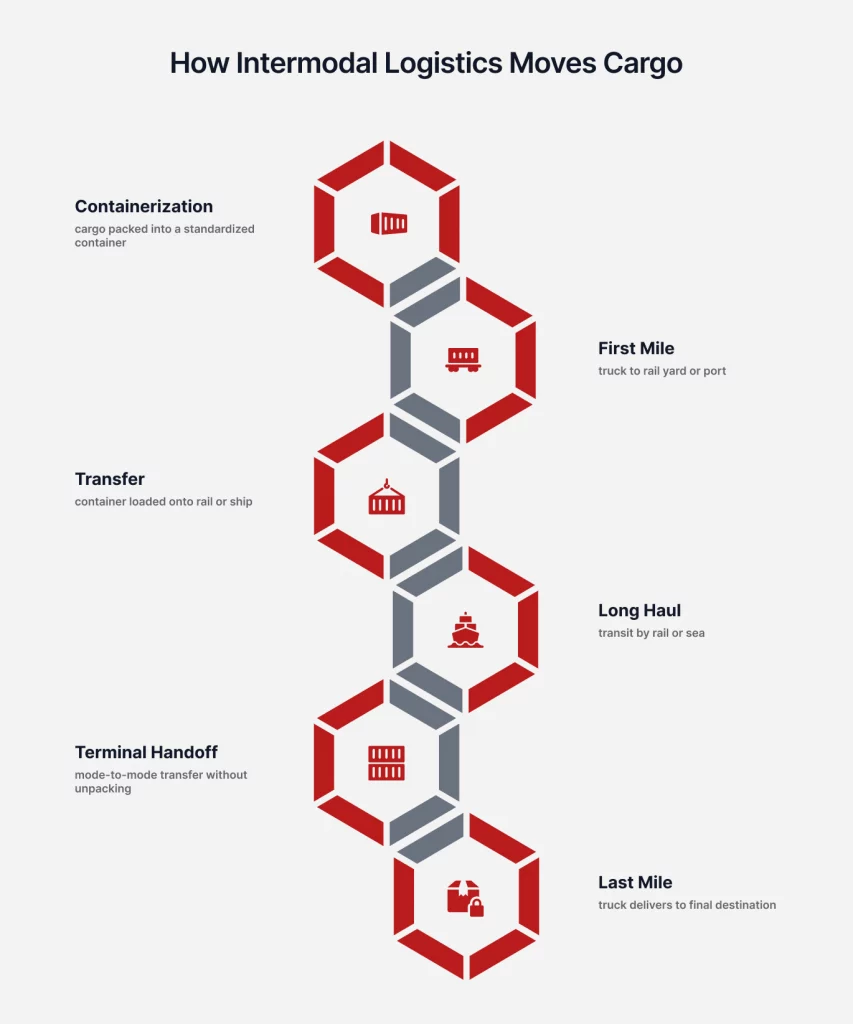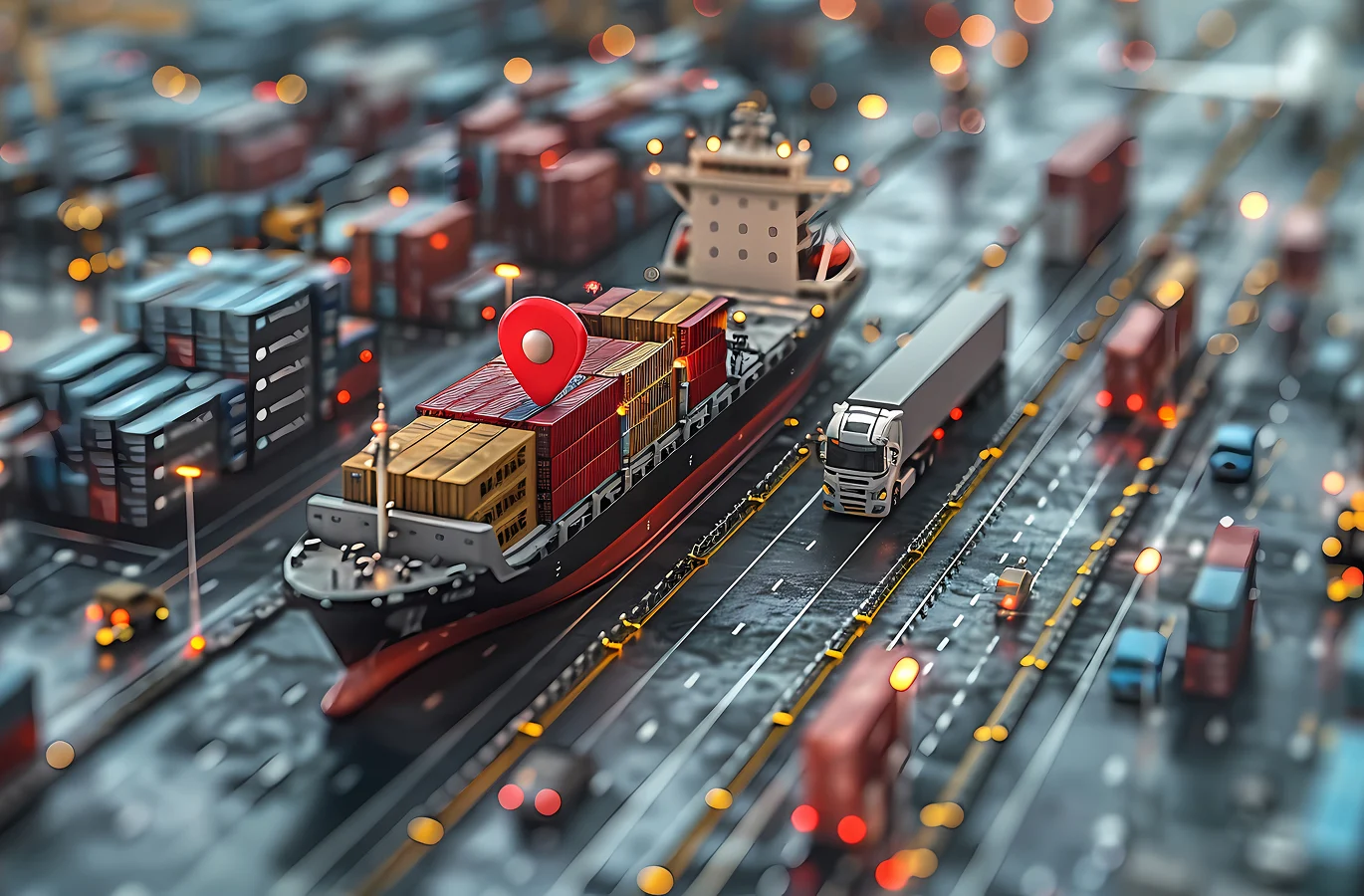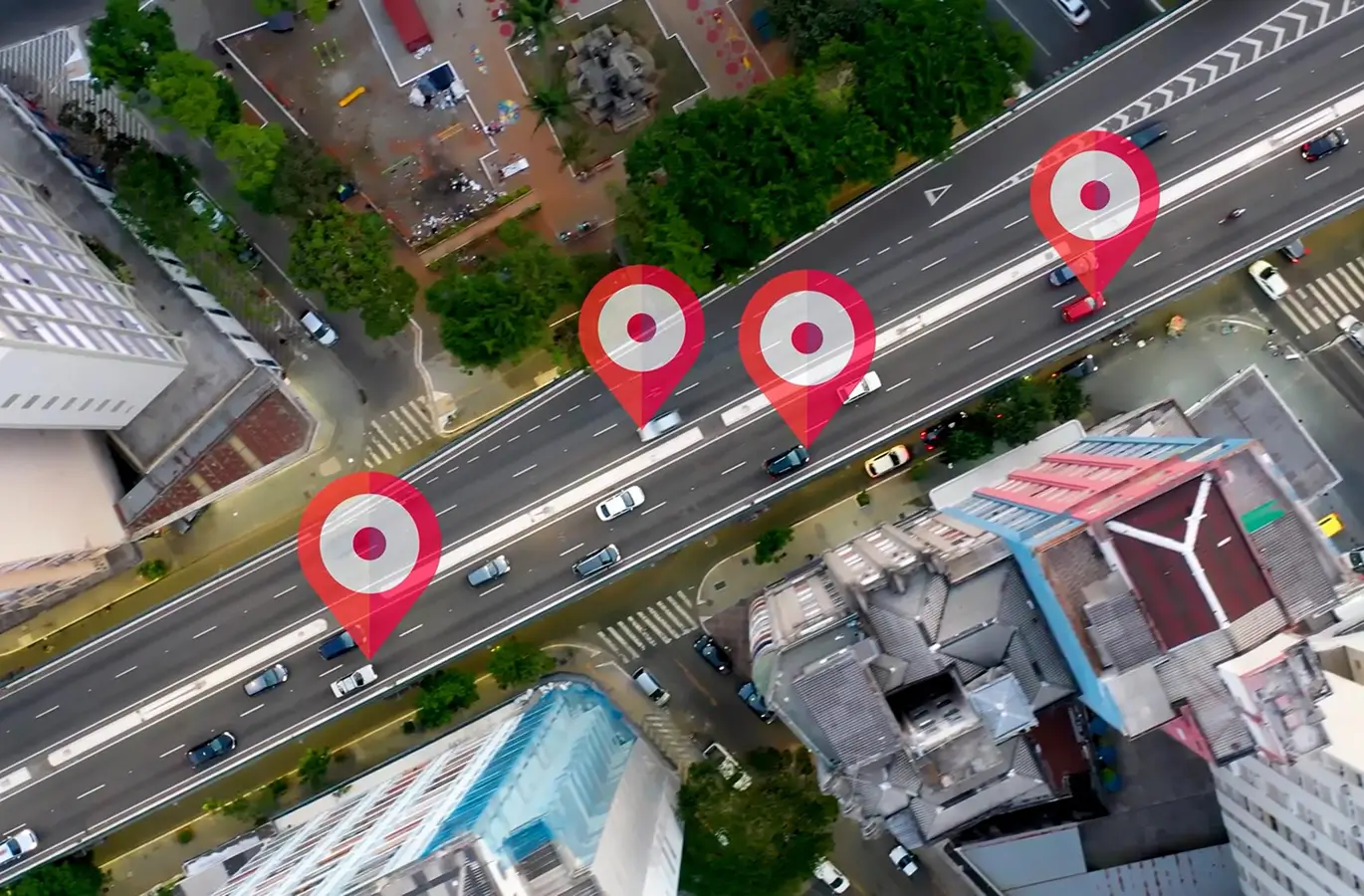Global trade has become increasingly complex, with goods traveling across countries, oceans, and continents before reaching their final destinations. Rarely does a shipment travel on just one mode of transport.
Instead, it passes through multiple carriers like ships, trains, and trucks, before being delivered to customers. Managing these transitions smoothly is where intermodal logistics plays a crucial role.
Intermodal logistics is the backbone of modern supply chains. It enables cargo to move efficiently across rail, sea, and road by utilizing standardized containers that can be transferred seamlessly between different modes. This approach reduces costs, improves reliability, and supports the massive scale of global trade.
For businesses and fleets, understanding intermodal logistics is critical. It explains how goods move from origin to destination, why multiple transport modes are used, and how visibility at each stage ensures shipments arrive safely and on time. This beginner’s guide breaks it all down, from definition and process to benefits, challenges, and future trends.
What is Intermodal Logistics
Intermodal logistics is the movement of goods using two or more modes of transport without handling the cargo itself when changing carriers. The cargo stays inside a single standardized container — often a 20-foot or 40-foot shipping container — that is transferred between trucks, trains, and ships as needed.
Intermodal vs Multimodal
It is common to confuse intermodal with multimodal transportation. The difference lies in how contracts are managed:
- Intermodal involves multiple contracts, one for each carrier. For example, a trucking company handles road transport while a rail operator manages the train leg.
- Multimodal uses a single contract with a logistics provider who oversees the entire journey, even though multiple modes of transportation are involved.
Why Containers Are the Key
The concept of containerization enabled intermodal transport. Standardized containers can be lifted directly from a truck to a ship or a railcar without needing to unpack the goods. This reduces handling costs, minimizes damage, and speeds up transfers between modes.
Why It Matters Today
Intermodal logistics provides the flexibility and efficiency needed for global supply chains. By combining the strengths of each mode, whether it is ships for long-distance travel, rail for cost efficiency, and trucks for flexibility, businesses can move cargo more reliably and at a lower cost.
How Intermodal Logistics Works
At its core, intermodal logistics involves moving goods through various modes of transport while keeping them within the same container. The key is coordination between carriers, terminals, and technology platforms that track shipments across the journey.
Step 1: Packing and Containerization
The process begins at the point of origin, where cargo is packed into a standardized container. These containers are designed to fit seamlessly across trucks, ships, and trains, which eliminates the need for unloading and repacking.
Step 2: First-Mile Road Transport
Trucks usually handle the first leg of the journey, moving the container from the factory, warehouse, or supplier to a rail yard or port. This “first mile” is crucial because it connects businesses to larger transport networks.
Step 3: Transfer to Rail or Ship
At the terminal, the container is lifted directly from the truck onto a train or vessel. Rail is often chosen for long inland distances due to its lower cost per mile. At the same time, ocean shipping is used for international transport.
Step 4: Long-Haul Transit
The container travels via rail or sea to the destination region. Throughout this stage, technology platforms track the container’s location, giving managers visibility into progress and estimated arrival times.
Step 5: Terminal Handoffs
When the container reaches a new terminal, it is unloaded from one mode and transferred to another without opening it. This process minimizes handling risks, reduces theft or damage, and speeds up the flow of goods.
Step 6: Last-Mile Delivery
Trucks handle the final leg, delivering the container to its destination. This last mile is often the most complex, as it involves navigating local roads, meeting customer delivery windows, and ensuring compliance with local regulations.
The Intermodal Logistics Flow

Benefits of Intermodal Logistics
Intermodal logistics is not just about moving containers across different modes of transportation. It is about unlocking advantages that improve efficiency, reduce costs, and support sustainable growth. For shippers and fleets, the benefits make intermodal a cornerstone of modern supply chains.
Cost Efficiency
Rail and sea transport are typically less expensive than road transport for long distances. By combining modes, businesses cut costs while still reaching destinations reliably. Using trucks only for the first and last miles reduces fuel expenses and driver hours, which are often the most expensive parts of logistics.
Sustainability and Fuel Savings
Rail and ships can move larger volumes with lower fuel consumption per ton-mile compared to trucks. This reduces greenhouse gas emissions and supports sustainability goals. As customers increasingly demand greener supply chains, intermodal logistics provides a practical solution.
Flexibility in Routing
Intermodal logistics offers options. If a port is congested, shipments can be rerouted through alternative terminals or inland rail networks. This flexibility enables companies to adapt quickly to disruptions while maintaining uninterrupted supply chain operations.
Reliability for Long-Distance Shipping
For long-haul shipments, rail and sea are often more consistent than road alone. Rail avoids highway congestion, while ships carry massive volumes with predictable schedules. When combined with road transport for flexibility, intermodal logistics delivers reliability on a large scale.
Scalability for Global Trade
As trade volumes grow, intermodal logistics scales easily. Standardized containers and established intermodal hubs allow businesses to increase shipments without reinventing their processes. This scalability is critical for companies expanding across regions or entering international markets.
Security and Reduced Risk
Containers remain sealed during transfers between modes of transportation. This reduces theft, tampering, and damage compared to shipments that require unpacking and repacking multiple times. For industries handling high-value or sensitive goods, this added security is a major benefit.
Challenges in Intermodal Logistics
While intermodal logistics delivers cost savings and flexibility, it is not without its challenges. Moving cargo across multiple modes requires coordination, infrastructure, and visibility at every stage of the process. Understanding these hurdles is the first step in developing solutions that maintain the efficiency of intermodal supply chains.
Coordination Across Multiple Carriers
Each mode of transport involves different operators, from trucking companies to rail providers and ocean carriers. Coordinating schedules, contracts, and responsibilities can be complex, especially when delays in one mode affect the entire chain.
Infrastructure Bottlenecks
Intermodal success depends on well-functioning terminals, ports, and rail yards. Congested ports or underdeveloped infrastructure can slow transfers between modes. These bottlenecks often create ripple effects that delay shipments downstream.
Delays at Terminals and Ports
Customs clearance, paperwork, and equipment shortages can lead to prolonged wait times at ports and terminals. When containers sit idle waiting for transfer, the efficiency gains of intermodal logistics are reduced.
Tracking Complexity
Unlike single-mode transport, intermodal logistics involves multiple handoffs. Without integrated tracking systems, shippers may lose visibility when cargo moves from one carrier to another. This creates uncertainty about location, status, and estimated delivery times.
Regulatory and Compliance Challenges
Each mode may be subject to different regulations, from safety and emissions standards to customs requirements. Managing compliance across carriers and countries requires expertise and often slows operations.
How Digitalization Helps
Technology platforms are addressing many of these challenges. Integrated tracking systems offer real-time visibility across modes, while digital documentation streamlines customs and compliance processes. Platforms that connect shippers, carriers, and customers in one view are transforming intermodal logistics from complex to manageable.
The Future of Intermodal Logistics
Intermodal logistics is evolving quickly as global trade, customer expectations, and sustainability pressures reshape supply chains. The future will rely heavily on digital platforms, connected assets, and greener strategies to keep goods moving efficiently across modes.
Digital Platforms for Coordination
Fragmented communication is one of the biggest challenges in intermodal logistics. Emerging platforms bring all stakeholders like shippers, carriers, port operators, and customers together into a single, connected system. This integration reduces delays, improves coordination, and gives everyone visibility into the same information.
IoT and Real-Time Visibility
Internet of Things (IoT) devices are transforming container tracking. Smart sensors monitor location, temperature, and condition in real time, ensuring sensitive cargo is protected and shipments stay on schedule. Fleets gain the ability to act immediately when disruptions occur.
Automation at Terminals and Ports
Automated cranes, robotics, and digital customs processes are speeding up container transfers at ports and rail yards. This reduces bottlenecks, allowing terminals to handle larger volumes without sacrificing efficiency.
Sustainability and Green Shipping
Governments and customers alike are demanding greener supply chains. Intermodal logistics supports sustainability by shifting long-haul transport to rail and ships, which are more fuel-efficient per ton-mile than trucks. Future systems will also track emissions more precisely, allowing companies to meet environmental goals.
Policy and Infrastructure Development
Governments worldwide are investing in rail networks, port expansions, and cross-border corridors. These projects will strengthen intermodal capacity and reliability, making it easier for businesses to move cargo across regions.
Trends Shaping Intermodal Logistics

Why Visibility Still Matters for Fleets
Even on a global scale, fleets remain central to the intermodal logistics process. Trucks almost always handle the first mile, moving containers from factories or warehouses to ports and terminals, and the last mile, delivering goods to final destinations. These legs of the journey are often the most visible to customers and the most vulnerable to delays.
First and Last Mile Complexity
While ships and trains move goods in bulk, trucks must navigate local roads, city congestion, and strict delivery windows. Any delays here affect the entire intermodal chain. A shipment that arrives at a port on time still risks failure if the last-mile delivery fails to meet a customer’s expectations.
Why Visibility is Critical
Fleets operating in intermodal logistics require real-time tracking, compliance readiness, and efficient repair workflows to maintain intact schedules. Visibility ensures managers know where vehicles are, whether they are road-ready, and when deliveries will be completed. Without it, even a well-planned intermodal operation can fall apart at the final stage.
REACH’s Role in Intermodal Success
This is where REACH adds value. By digitizing inspections, automating service workflows, and providing live tracking, REACH empowers fleets to ensure their vehicles are always road-ready. Compliance records are audit-ready, repair progress is visible, and managers gain confidence that the first and last mile will not jeopardize the larger intermodal journey.
Connecting Local Fleets to Global Logistics
Intermodal logistics may span oceans and continents, but its success depends on fleets at the start and finish. By strengthening visibility and accountability in these critical legs, REACH helps fleets become reliable links in global supply chains.
Intermodal Made Simple
Intermodal logistics is the engine behind modern global trade. Combining multiple transport modes, such as rail, sea, and road, enables goods to move further, faster, and more cost-effectively than relying on a single mode alone. Containerization, digital tracking, and coordinated handoffs enable businesses to ship at scale while reducing costs and emissions.
Yet intermodal success depends on more than long-haul efficiency. The first and last mile, usually handled by fleets, remains critical. Without visibility, compliance, and reliability in these final stages, even the most efficient global journey can fail to meet customer expectations.
This is where REACH strengthens the chain. By digitizing fleet operations, automating service requests, and ensuring real-time visibility, REACH makes the first and last mile dependable. Fleets using REACH become the reliable link that keeps intermodal logistics running smoothly from origin to destination.
Key Takeaways
- Intermodal logistics combines two or more transport modes without unpacking cargo, using standardized containers.
- It differs from multimodal transport because each carrier has its own contract.
- Benefits include cost savings, sustainability, flexibility, scalability, and reduced risk.
- Challenges include coordination, infrastructure bottlenecks, tracking complexity, and regulatory requirements.
- Future trends include digital platforms, IoT, automation, sustainability, and infrastructure investment.
- Fleets remain vital in the first and last mile, where REACH ensures vehicles stay compliant, visible, and reliable.
Frequently Asked Questions (FAQs)
-
What is intermodal logistics?
Intermodal logistics refers to the movement of goods using two or more modes of transportation, such as trucks, trains, and ships. Cargo remains inside a standardized container that is transferred between carriers without being unpacked.
-
How is intermodal transportation different from multimodal transportation?
Intermodal uses multiple contracts with different carriers for each mode. In contrast, multimodal uses a single contract with a logistics provider that manages the entire journey.
-
What are the benefits of intermodal logistics?
Key benefits include lower transportation costs, reduced emissions, flexible routing options, reliable long-distance shipping, and stronger cargo security.
-
What industries use intermodal logistics?
Industries such as retail, manufacturing, automotive, food and beverage, and e-commerce utilize intermodal logistics to ship goods across regions and countries efficiently.
-
What challenges does intermodal logistics face?
Common challenges include complex coordination between carriers, port congestion, infrastructure bottlenecks, and difficulties maintaining shipment visibility.
-
What role does technology play in intermodal logistics?
Technology platforms provide real-time tracking, digital documentation, and better coordination across carriers, which helps reduce delays and improve transparency.
-
How does REACH support intermodal operations?
REACH ensures that first- and last-mile fleets stay compliant, visible, and reliable. It digitizes inspections, automates service workflows, and provides real-time tracking so that intermodal chains are not disrupted at critical stages.



